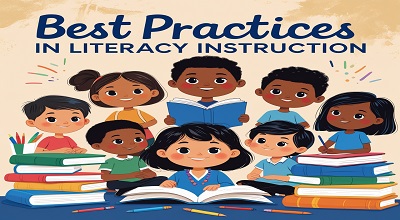Literacy Instruction
Literacy instruction is a cornerstone of education, shaping the ability of students to read, write, and communicate effectively. As the educational landscape evolves, so do the strategies and methodologies for teaching literacy. This article explores the latest best practices in literacy instruction, drawing on recent research and expert recommendations. From structured literacy approaches to integrating literacy across content areas, we will delve into the most effective strategies for fostering literacy skills in diverse classrooms.
Introduction to Literacy Instruction
Literacy is more than just the ability to read and write; it encompasses a range of skills, including comprehension, critical thinking, and communication. Effective literacy instruction equips students with the tools they need to succeed academically and in life. However, as classrooms become more diverse and technology continues to influence education, educators must adapt their practices to meet the needs of all learners.
The Importance of Literacy in Modern Education
Literacy is a foundational skill that impacts every aspect of a student’s education. Research shows that students who struggle with literacy are more likely to face challenges in other subjects, as reading and writing are integral to learning across disciplines. Moreover, literacy is a critical skill for navigating the modern world, where information is abundant and often text-based.
Why Literacy Matters?
- Academic Success: Literacy skills are essential for understanding and engaging with content in all subjects.
- Career Readiness: Strong literacy skills are a prerequisite for most careers, particularly in an increasingly digital world.
- Civic Engagement: Literacy enables individuals to participate fully in society, from understanding news articles to voting.
Best Practices in Literacy Instruction
Structured Literacy
Structured literacy is a research-based approach that emphasizes explicit, systematic instruction in phonics, vocabulary, and comprehension. This method is particularly effective for students with learning differences, such as dyslexia.
- Explicit Instruction: Teachers provide clear, direct explanations and demonstrations of literacy skills.
- Systematic Approach: Lessons follow a logical sequence, building on previously learned skills.
Integrating Literacy Across Content Areas
Literacy instruction should not be confined to language arts classes. Integrating literacy into other subjects helps students develop domain-specific skills and reinforces the importance of reading and writing in all areas of life.
- Writing in Every Classroom: Activities like quick writes and one-minute essays encourage students to practice writing regularly.
- Domain-Specific Skills: Teachers can incorporate subject-specific vocabulary and reading strategies into their lessons.
Leveraging Technology
Digital tools and resources can enhance literacy instruction by providing interactive and engaging learning experiences.
- Digital Textbooks: These can motivate students to read and provide additional resources for comprehension.
- Educational Apps: Apps designed for literacy instruction can offer personalized learning experiences.
Creating Literacy-Rich Environments
A literacy-rich environment fosters a love of reading and writing by surrounding students with opportunities to engage with text.
- Classroom Design: Intentional placement of books, writing materials, and visual aids encourages literacy activities
- Diverse Materials: Providing a variety of texts, including fiction, non-fiction, and multimedia resources, caters to different interests and reading levels.
Culturally Responsive Teaching
As classrooms become more diverse, it is essential to incorporate students’ cultural backgrounds into literacy instruction.
- Inclusive Texts: Use literature that reflects the experiences and identities of all students.
- Language Support: Provide targeted support for English learners to bridge language gaps
Challenges in Literacy Instruction
Despite the advancements in literacy instruction, educators face several challenges, including:
- Diverse Learning Needs: Meeting the needs of students with varying abilities and backgrounds requires differentiated instruction.
- Limited Resources: Many schools lack the funding and materials needed to implement best practices effectively.
- Teacher Training: Ensuring that teachers are equipped with the latest strategies and tools is critical for success.
Future Trends in Literacy Instruction
The field of literacy instruction continues to evolve, with emerging trends that promise to shape the future of education:
- Personalized Learning: Technology enables tailored instruction that meets the unique needs of each student.
- Focus on Critical Thinking: Literacy instruction is increasingly emphasizing skills like analysis and evaluation.
- Collaborative Learning: Group activities and discussions foster communication and teamwork skills.
Conclusion
Effective literacy instruction is essential for preparing students to thrive in school and beyond. By adopting best practices such as structured literacy, integrating literacy across content areas, and creating literacy-rich environments, educators can help all students develop the skills they need to succeed. As the educational landscape continues to change, staying informed about the latest research and trends will be crucial for ensuring that literacy instruction remains effective and relevant.
FAQs
1; What is structured literacy, and why is it important?
Structured literacy is a systematic, explicit approach to teaching reading and writing. It is particularly effective for students with learning differences, such as dyslexia, as it focuses on foundational skills like phonics and vocabulary.
2: How can teachers integrate literacy into other subjects?
Teachers can incorporate literacy into other subjects by using activities like quick writes, subject-specific vocabulary exercises, and reading strategies tailored to the content area.
3: What are some examples of literacy-rich environments?
A literacy-rich environment includes a variety of books, writing materials, and visual aids. Classroom design should encourage reading and writing activities, and materials should reflect diverse interests and reading levels
4: How can technology support literacy instruction?
Technology can enhance literacy instructionS through digital textbooks, educational apps, and interactive tools that provide personalized learning experiences.
5: Why is culturally responsive teaching important in literacy instructionS?
Culturally responsive teaching ensures that all students feel represented and valued. It involves using inclusive texts and providing language support for English learners to bridge achievement gaps.
